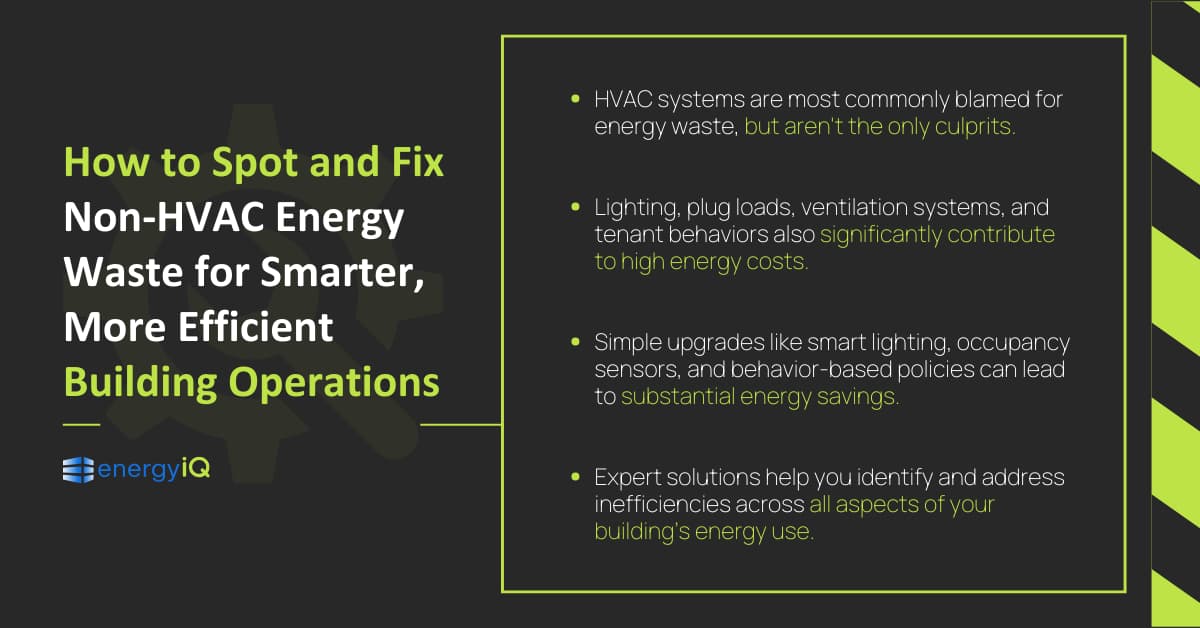Think HVAC is your building’s biggest energy problem? Here is how non-HVAC energy waste could be costing you even more without you realizing it.

You’ve invested in your HVAC, fine-tuned the settings, and made sure it’s running efficiently, so why is your energy bill still climbing?
The truth is, HVAC is only part of the story. Hidden energy drains like lighting, plug loads, ventilation, and daily habits quietly rack up costs–and often go unnoticed.
According to the US Department of Energy, commercial buildings waste an estimated 30% of the energy they consume. That’s a substantial amount of money, especially when energy costs are rising, sustainability demands are growing, and regulatory requirements continue to tighten.
But non-HVAC systems account for up to 60% of total energy use in commercial spaces–and they often go unaddressed in standard energy audits. That’s why you need to extend beyond cost savings to building smarter, more sustainable, and future-ready operations.
Keep reading to explore the often-overlooked sources of non-HVAC energy waste in your building as well as smart, practical strategies to tackle them.
Lighting: A silent culprit in energy drain
You might not give your building’s lighting much thought, but outdated systems could be quietly driving up your energy costs. Older fluorescent fixtures, always-on lighting, and inefficient controls are some of the biggest sources of non-HVAC energy waste in commercial spaces.
Upgrading to smart lighting and automation can deliver an immediate, measurable impact. You can then schedule lights to turn off after hours, adjust brightness based on occupancy, and control entire zones remotely.
The benefits go even further when you integrate smart lighting with occupancy sensors and daylight harvesting. Lights automatically dim or switch off in empty rooms or when there’s enough natural light, maximizing efficiency and cutting energy costs—all without extra effort.
Plug loads & idle equipment: The hidden vampire energy
Plug loads are one of the sneakiest, most overlooked sources of energy waste in your building. They include everything you plug into an outlet — office equipment, vending machines, microwaves, and coffee makers that often stay powered on long after everyone’s gone home.
The reason they slip under the radar is simple: Individually, they seem small. But when you add them all up, plug loads can make up a surprisingly large portion of your building’s total energy consumption.
Smart, simple solutions can help get these hidden energy drains under control. Programmable timers, smart plugs, and clear usage guidelines allow you to automate shut-offs, track real-time consumption, and make sure devices power down when not in use. Even better, monitoring plug load behavior gives you valuable insights into overall energy patterns, helping you fine-tune efficiency across your entire building.
Ventilation systems: More than just moving air
It’s easy to see ventilation as just moving air to keep spaces comfortable. But outdated systems can quietly drain energy, especially when running on rigid, fixed schedules that don’t reflect your building’s real-time needs.
Many ventilation systems are misconfigured, running at full capacity even when spaces are empty or require less airflow. The result? Wasted energy and inflated operating costs.
Upgrading to automated, demand-based ventilation makes a big difference. These systems adjust airflow based on CO₂ levels, occupancy, or time of day and deliver fresh air when and where it’s needed, rather than sticking to an “always-on” approach.
There’s also a bonus: Better ventilation efficiency supports your indoor air quality goals, so you’re also creating a healthier environment for everyone in the building.
Building envelope & insulation: Passive yet powerful
It’s easy to overlook the role your building envelope plays in energy efficiency. But poor insulation, drafty windows, and leaky doors can all quietly drain your energy budget without you even realizing it.
Many people think insulation is only important in cold climates, or that it just helps with heating and cooling. The truth is that a poorly sealed building affects your entire energy system, from HVAC load to humidity control and even lighting efficiency.
But simple, cost-effective upgrades can make a noticeable difference. Adding insulation to key areas, sealing gaps with door sweeps, or applying window film can significantly improve comfort and cut energy waste, and often without major renovations.
Enhancing your building envelope supports your sustainability goals by helping your structure work in harmony with your energy systems, reducing both your operational costs and environmental footprint.
Operational habits & human behavior
Tenant behavior can have a huge impact on your building’s energy use. Small actions like leaving lights on, improperly using office equipment, or cranking up the heat quickly add up to higher energy costs.
Creating building-wide policies and educating tenants about energy-saving habits is a great place to start. Simple reminders like turning off lights when not in use or using equipment more efficiently can lead to significant savings over time.
Behavioral nudges like digital signage or notifications about energy usage also help shift habits in the right direction. Tools that track and display usage trends allow you to see where improvements can be made, making it easier to guide tenants toward responsible energy practices.
Data-driven solutions: The role of smart analytics
Tracking and analyzing your building’s energy consumption in real-time can make all the difference in identifying and reducing non-HVAC energy waste. Smart sensors and data analytics detect inefficiencies that often go unnoticed.
Advanced energy solutions now offer detailed building energy consumption analysis, giving you a clear view of what’s consuming energy and when. The right data can help you use automation and predictive maintenance to optimize your energy use and prevent costly issues before they arise.
Go beyond HVAC energy savings with EnergyIQ
HVAC systems aren’t the only contributors to energy waste in commercial buildings. Lighting, plug loads, ventilation, and even tenant behavior can silently drive up your energy costs. A holistic approach to energy analysis is essential in uncovering these hidden inefficiencies, helping you implement actionable strategies that make a real difference.
At Energy IQ, we believe in going beyond just HVAC to provide a comprehensive analysis of your building’s energy performance. We help you address every area of energy use with data-driven insights and comprehensive assessments to drive long-term savings and advance your sustainability goals.
Curious about what’s quietly costing you? Book a personalized energy assessment with us today and start your path toward smarter, more efficient, and sustainable energy management.



